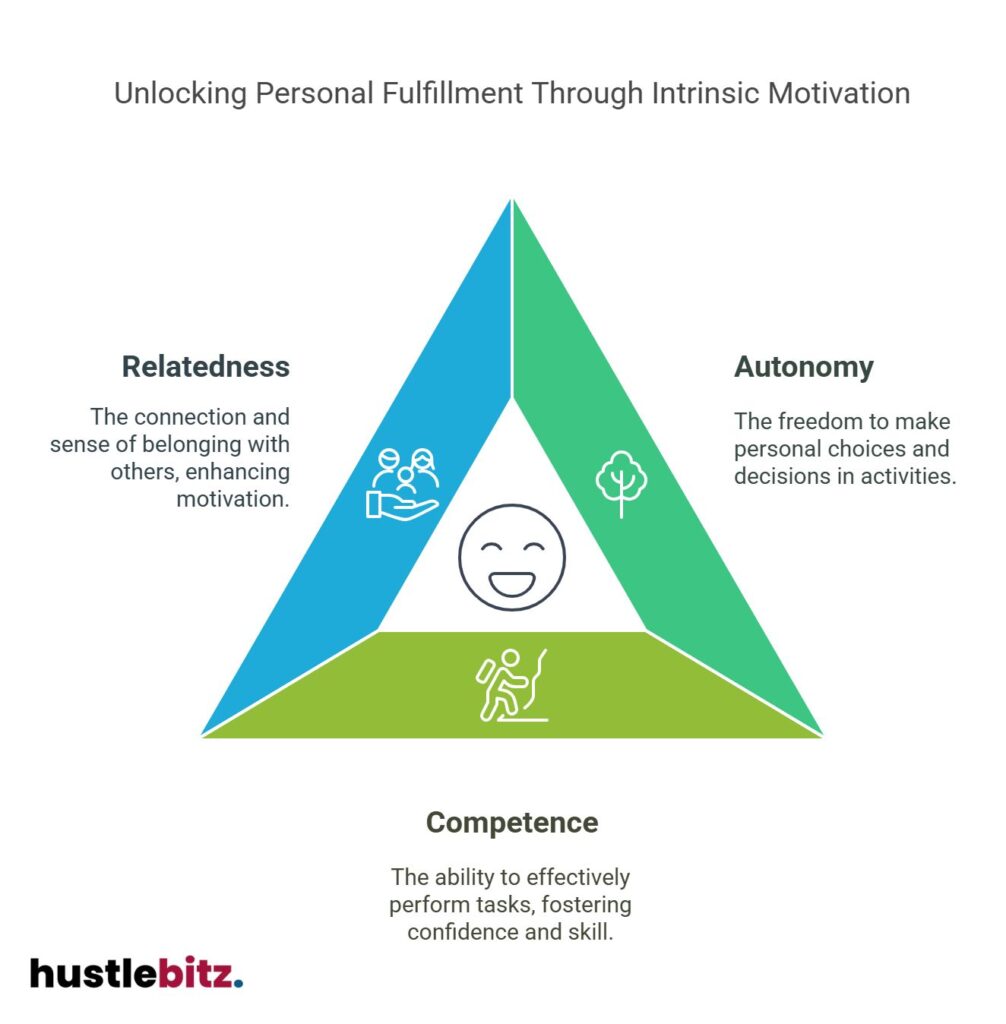Understanding intrinsic motivation is vital for achieving sustainable drive in personal and professional pursuits. This internal motivation stems from the enjoyment and fulfillment derived from engaging in activities. It enhances creativity, fosters higher engagement, and contributes to long-term satisfaction. In contrast to extrinsic motivation, which relies on external rewards, intrinsic motivation cultivates a deeper connection to tasks. By aligning personal interests and values, individuals can experience continuous growth and improve overall well-being. Exploring real-life applications and effective strategies can further enhance your grasp of how to harness this powerful motivator.
Key Takeaways
- Intrinsic motivation stems from engaging in activities for personal satisfaction, enhancing creativity and fostering a sense of purpose.
- It differs from extrinsic motivation, which relies on external rewards, potentially undermining genuine interest.
- Key components include autonomy, competence, and relatedness, which support sustained engagement and personal growth.
- Strategies like effective goal setting, passion projects, and self-directed learning cultivate intrinsic motivation and enrich personal fulfillment.
- Real-life examples, such as volunteer work and creative pursuits, illustrate the profound impact of intrinsic motivation on personal and professional success.

Defining Intrinsic Motivation

Intrinsic motivation refers to the internal drive to engage in activities for their inherent satisfaction and enjoyment, rather than for external rewards or recognition. This form of motivation is crucial for fostering personal fulfillment and encourages individuals to pursue passion projects that resonate with their interests and values.
Rooted in self-determination theory, intrinsic motivation emphasizes the importance of autonomy support, allowing individuals the freedom to explore and create in ways that align with their personal goals.
The intrinsic drive is often fueled by internal rewards, such as a sense of accomplishment or emotional engagement in the task at hand. When individuals align their activities with a sense of purpose, they experience a more profound connection to their work, enhancing creativity and innovation.
This alignment fosters an environment where goal-setting strategies can be effectively implemented, leading to sustained motivation and productivity.
Moreover, engaging in tasks that are intrinsically motivating tends to cultivate resilience in the face of challenges, as individuals are more likely to persist through difficulties when they are emotionally invested in their activities.
This emotional engagement not only boosts creativity enhancement but also contributes to overall well-being. By understanding and harnessing the power of intrinsic motivation, individuals can create an enriching cycle of learning and growth, ultimately leading to a more fulfilling life.
Thus, recognizing the components that drive intrinsic motivation is essential for anyone seeking to enhance their personal and professional development.
The Science Behind Motivation
Understanding the science behind motivation involves exploring various psychological theories and frameworks that explain how and why individuals are driven to pursue specific goals and activities. Central to this exploration is the neuroscience of motivation, which investigates the brain’s role in reward processing and goal-directed behavior. Psychological theories, such as Maslow’s hierarchy of needs and Self-Determination Theory, provide foundational insights into what motivates individuals across different contexts.
Motivation measurement tools, such as surveys and assessments, help quantify individuals’ intrinsic and extrinsic motivational factors, allowing for a deeper understanding of how motivation varies. The role of emotions is crucial; positive feelings often enhance motivation, while negative emotions can hinder it. This interplay significantly impacts performance in various domains, including motivation in education, where engaged students typically achieve better outcomes.
In the workplace, motivation strategies such as fostering a supportive culture and recognizing individual contributions can enhance employee engagement and productivity. Additionally, cultural influences shape motivational drives, as different cultures may prioritize community achievements over personal ones.
The relationship between motivation and creativity is also noteworthy; high levels of intrinsic motivation often correlate with increased creative output.
Differentiating Intrinsic and Extrinsic
Motivation can be broadly categorized into intrinsic and extrinsic types, each serving distinct purposes and influencing behavior in unique ways.
Intrinsic motivation arises from within an individual, driven by personal fulfillment and an inherent interest in the task itself. This motivation type often leads to heightened task engagement, as individuals pursue activities for their own sake, thereby enhancing creativity and fostering enriching learning experiences. Psychological factors such as autonomy, mastery, and purpose play pivotal roles in nurturing intrinsic motivation, which aligns closely with long-term goals and emotional well-being.
In contrast, extrinsic motivation is fueled by external rewards or recognition, such as monetary incentives, grades, or praise. While effective in driving short-term performance outcomes, reliance on extrinsic motivation may inadvertently undermine intrinsic motivation. When individuals focus primarily on reward systems, they may experience a decline in their intrinsic interest in the task, leading to reduced personal fulfillment and less engagement in the long run.
Understanding the differences between these motivation types is crucial for individuals and organizations aiming to cultivate an environment conducive to sustained motivation.
Benefits of Intrinsic Motivation

Fostering intrinsic motivation yields numerous benefits that enhance both individual performance and overall well-being.
When individuals engage in activities driven by internal desires, they experience a profound sense of personal fulfillment and emotional well-being. This intrinsic drive not only cultivates a deeper connection to one’s work or studies but also encourages resilience building and self-determination.
The advantages of intrinsic motivation are manifold:
- Academic Success: Students motivated by intrinsic factors often exhibit higher levels of engagement and achievement in their studies.
- Job Satisfaction: Employees who pursue passion projects and find meaning in their work demonstrate greater satisfaction and commitment to their roles.
- Creative Expression: Individuals motivated by their interests are more likely to explore innovative ideas and solutions, leading to enhanced creativity.
- Lifelong Learning: Intrinsic motivation fosters a love for learning, encouraging individuals to continually seek knowledge and personal growth.
Moreover, intrinsic motivation contributes to health benefits, as individuals who are engaged in fulfilling activities often experience lower stress levels and improved overall health.
By nurturing this form of motivation, individuals cultivate a powerful drive that not only supports their personal and professional aspirations but also enriches their lives holistically.
Emphasizing intrinsic motivation can lead to a more engaged, satisfied, and resilient workforce and student body, ultimately benefiting society as a whole.
How Intrinsic Motivation Works

Intrinsic motivation operates through the alignment of personal interests and values with the tasks at hand, creating a powerful drive that compels individuals to engage in activities for their inherent enjoyment and satisfaction.
According to self-determination theory, this intrinsic drive is rooted in the fulfillment of three psychological needs: autonomy, competence, and relatedness. When these needs are met, individuals experience enhanced motivation processes that lead to higher engagement levels and greater personal fulfillment.
Enjoyment factors play a crucial role in fostering intrinsic motivation. Activities that resonate with an individual’s passions naturally enhance creativity, encouraging a willingness to explore and innovate. In this context, challenge acceptance becomes a vital aspect, as individuals are more likely to embrace obstacles as opportunities for growth rather than deterrents.
Goal setting also significantly influences how intrinsic motivation manifests. When individuals set personal goals that align with their values, they create a framework for meaningful learning experiences. This alignment not only promotes persistence but also amplifies the sense of accomplishment when goals are achieved, further reinforcing the motivational cycle.
Moreover, the interplay between intrinsic motivation and engagement levels contributes to sustained interest in various pursuits. As individuals delve deeper into their chosen activities, they often find themselves immersed in a state of flow, where time seems to dissolve, and creativity flourishes.
Thus, understanding how intrinsic motivation works is essential for cultivating environments that support and nurture this fundamental drive.
Real-Life Examples of Intrinsic Motivation

Numerous real-life examples illustrate the profound impact of intrinsic motivation across various domains, from education to personal hobbies. Individuals often engage in activities driven by their internal desires rather than external rewards, leading to enhanced satisfaction and fulfillment.
Creative Pursuits: Artists and writers frequently create not for monetary gain but for the joy of artistic expression and the exploration of their ideas. This passion fuels their creativity and enriches their personal growth.
Volunteer Work: Many volunteer because they find purpose in helping others, cultivating social connections and a deep sense of community. Their actions stem from a desire to contribute meaningfully rather than from obligation or compensation.
Sports Enjoyment: Athletes often participate in sports for the sheer enjoyment and challenge it brings, fostering a commitment to their fitness journey. Their motivation is driven by personal achievement and a love for the game, rather than external accolades.
Learning Curiosity: Students who pursue knowledge out of a genuine interest often excel academically. Their intrinsic motivation to learn fosters a deeper understanding of subjects, enhancing their educational experience and leading to long-term career fulfillment.
These examples underscore the essence of intrinsic motivation: it is about the joy of engaging in activities that align with one’s values and interests, promoting not just individual satisfaction but also significant personal growth and fulfillment across various life aspects.
Strategies to Cultivate Intrinsic Motivation

Cultivating intrinsic motivation can enhance personal engagement and satisfaction across various activities, building on the understanding that internal drives often yield deeper fulfillment than external rewards. To foster this, individuals can employ several strategies that align with personal values and interests.
Effective goal setting is essential; setting specific, attainable goals linked to one’s values can create a sense of purpose. This, in turn, can lead to intrinsic rewards such as personal growth and satisfaction. Engaging in passion projects allows for creative expression, which not only nurtures intrinsic motivation but also enriches one’s skill set.
Self-directed learning is another powerful approach, allowing individuals to explore topics of interest at their own pace, thus fueling curiosity cultivation. Incorporating mindfulness practices can enhance self-awareness, making it easier to identify what truly motivates and excites us.
Utilizing positive reinforcement can also help sustain intrinsic motivation by acknowledging efforts and progress, rather than merely outcomes. Additionally, providing autonomy support is crucial; individuals should be encouraged to make choices and take ownership of their learning and activities.
Lastly, fostering an environment that prioritizes creative expression and encourages exploration will lead to sustained intrinsic motivation. By implementing these strategies, individuals can create a fulfilling framework that not only enhances personal engagement but also promotes a lifelong passion for learning and growth.
Final Thoughts
Understanding and cultivating intrinsic motivation is crucial for achieving long-term personal and professional fulfillment. By focusing on activities that align with personal values and interests, individuals can foster a deep sense of satisfaction and engagement. Implementing strategies such as effective goal setting, self-directed learning, and creative expression enhances this internal drive, leading to sustained motivation and continuous growth. Prioritizing intrinsic motivation not only improves overall well-being but also empowers individuals to pursue their passions with greater resilience and enthusiasm, ultimately leading to a more fulfilling and purpose-driven life.




